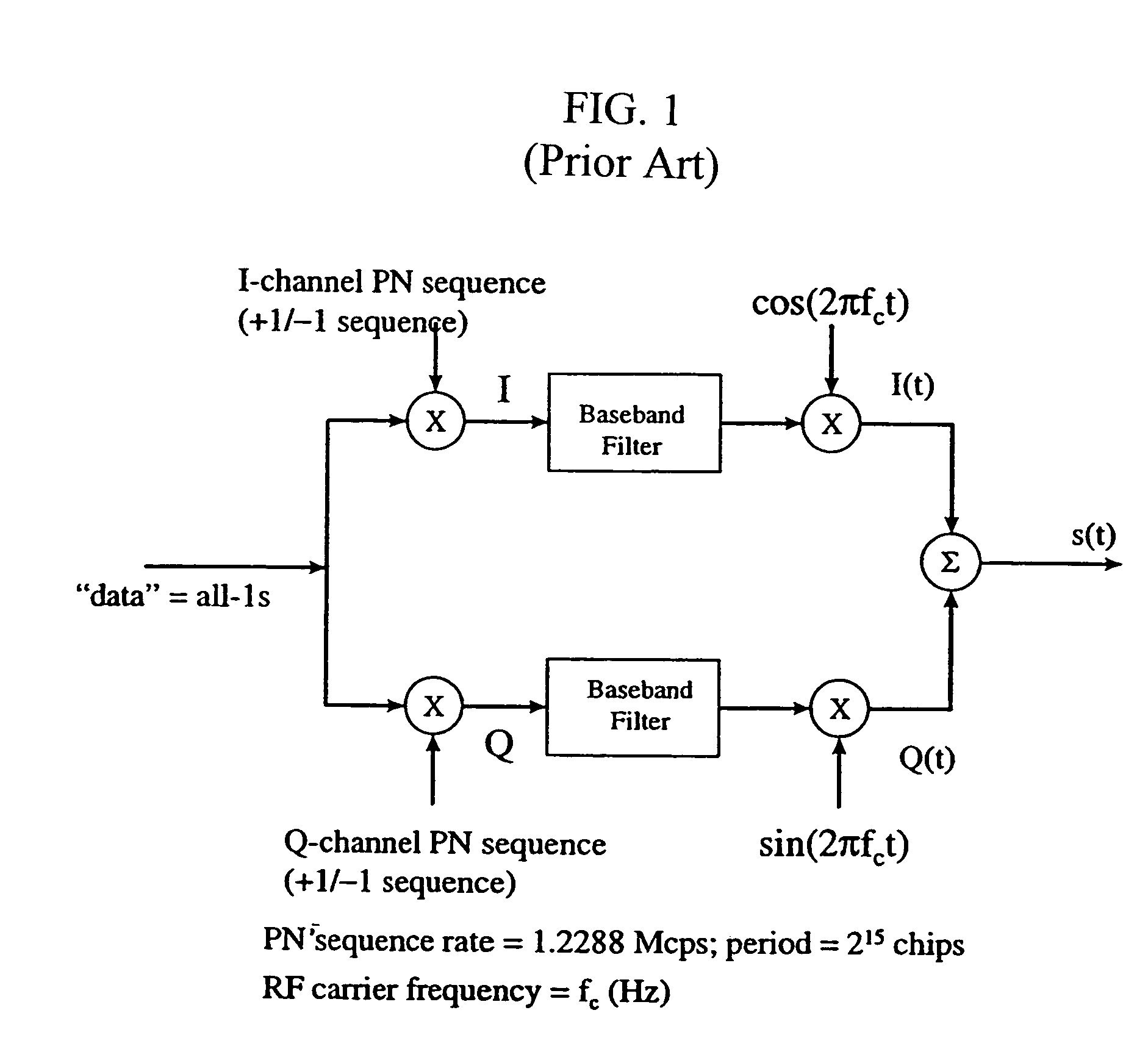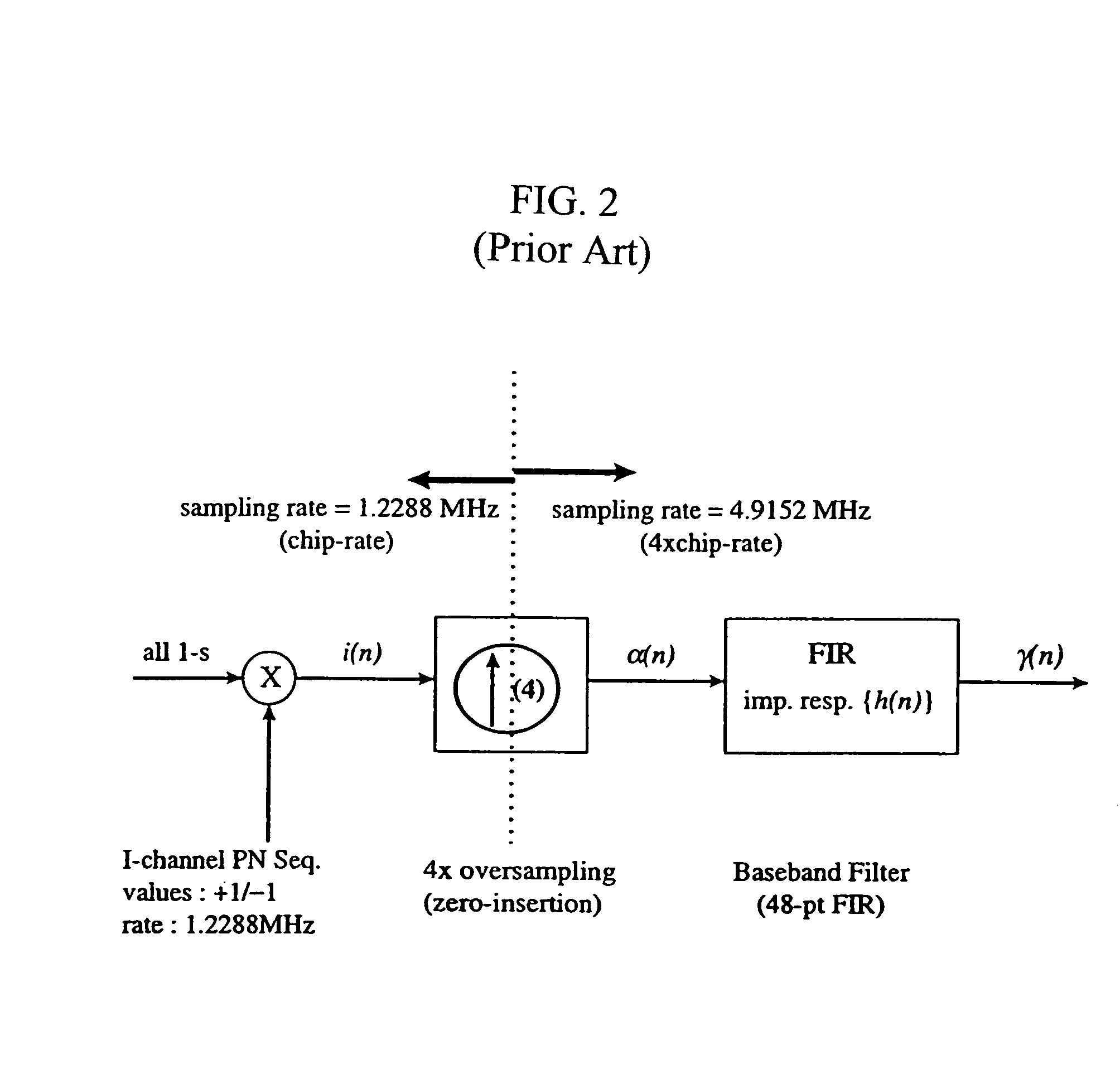Pilot tracking for synchronization using correlation between digital signal and locally generated version of PN signal
a pilot tracking and digital signal technology, applied in the field of cdma pilot tracking for synchronization, can solve the problems of requiring roughly 60 million multipliers per, errors in pilot tracking, and far beyond the capabilities of any current off-the-shelf dsp, and achieve the effect of reducing computational load and improving accuracy
- Summary
- Abstract
- Description
- Claims
- Application Information
AI Technical Summary
Benefits of technology
Problems solved by technology
Method used
Image
Examples
example 1
[0099]Synchronization equipment provides a timing output. An output is obtained by disciplining a local oscillator (e.g., rubidium or quartz).
[0100]A control signal for disciplining (i.e. adjusting the frequency of) the local oscillator is obtained by monitoring CDMA (cellular telephony / PCS telephony) off-air signal transmitted from one or several Base-Stations. If more than one Base-Station can be monitored, then a “Multiple-Input Frequency Locked Loop” (or MIFLL) algorithm is employed to achieve the best (weighted) average [weight assigned based on deriving a figure-of-merit] of the several Base-Stations monitored. {Unlike CDMA telephones which control their local oscillator based on the signal from just 1 Base-Station}.
[0101]Monitoring a Base-Station involves acquiring and tracking the “Pilot Channel” that each Base-Station transmits. {Tracking is achieved by keeping a free-running counter, timed by the disciplined local oscillator, and having a modulus equal to the time-period o...
example 2
[0102]This has to do with frequency planning. Let fc be the chip-rate (1.2288 MHz); fs is the sampling rate of the A / D converter; f0 is the carrier frequency at RF; fL is the effective carrier frequency after down-conversion. fD is the effective carrier frequency after down-conversion and conversion to digital by the A / D converter. Then:[0103]Choose fs=4·fD {this has some very nice properties when I synthesize the I and Q (i.e. the In-phase and Quadrature signals)}[0104]Choose fD≧fc {this preserves the double-sideband property, allowing us to use a single A / D converter and do the I / Q separation in the digital signal processing}[0105]Choose fL=fD+k·fs where k is an integer {This essentially describes the mode of aliasing. The center frequency fL automatically gets translated to fD. The integer k is chosen such that the down-converted RF signal is within the conversion bandwidth of the A / D converter}
[0106]The following values were chosen: fD=fc(=1.2288 MHz); and set fs=4·fc(=4.9152 MH...
example 3
[0107]The CDMA scheme uses an I-channel code and a Q-channel code that are different PN codes (PN==Pseudo Noise; to distinguish them from Pseudo Random Binary Sequences). The same data is modulated onto both codes and the I-channel signal and Q-channel signal modulated onto the In-phase and Quadrature versions of the RF carrier. Since the local oscillator in the receiver may have a phase offset from the RF carrier in the transmitter, the receiver needs to perform the I-code and Q-code correlations on both the In-phase and Quadrature components on the down-converted signal. This would need four correlators. Since the date is the same on both the I-channel and Q-channel codes the results from the four correlators can be combined in pairs to provide one (complex; i.e. with real-part and imaginary-part) correlation value. When I use the term “correlation value” I mean the magnitude-squared of this complex number, that is, the sum of the squares of the real and imaginary parts.
[0108]The ...
PUM
 Login to View More
Login to View More Abstract
Description
Claims
Application Information
 Login to View More
Login to View More - R&D
- Intellectual Property
- Life Sciences
- Materials
- Tech Scout
- Unparalleled Data Quality
- Higher Quality Content
- 60% Fewer Hallucinations
Browse by: Latest US Patents, China's latest patents, Technical Efficacy Thesaurus, Application Domain, Technology Topic, Popular Technical Reports.
© 2025 PatSnap. All rights reserved.Legal|Privacy policy|Modern Slavery Act Transparency Statement|Sitemap|About US| Contact US: help@patsnap.com



